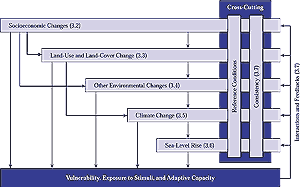3.1.3.1. Exploratory Scenarios
Exploratory (or descriptive) scenarios describe how the future might unfold,
according to known processes of change or as extrapolations of past trends.
They are sometimes described as BAU scenarios; often they involve no major interventions
or paridigm shifts in the organization or functioning of a system but merely
respect established constraints on future development (e.g., finite resources,
limits on consumption). However, the term "business-as-usual" may
be misleading because exploratory scenarios also can describe futures that bifurcate
at some point (an example might be uptake or rejection of a new technology)
or that make some assumptions about regulation and/or adaptation of a system.
The simplest model is a direct extrapolation of past trends (e.g., projection
of future agricultural crop productivity often is based on extrapolation of
recorded increases in productivity; Mela and Suvanto, 1987; Alexandratos, 1995).
Most climate scenarios considered in this report can be regarded as exploratory:
They are future climates that might occur in the absence of explicit policies
of GHG reduction.
3.1.3.2. Normative Scenarios
|

Figure 3-1: Types of scenarios required in climate impact, adaptation,
and vulnerability assessment and their interactions. Numbers in parentheses
refer to sections of this chapter.
|
Normative (or prescriptive) scenarios describe a prespecified
future, presenting "a picture of the world achievable (or avoidable) only
through certain actions. The scenario itself becomes an argument for taking
those actions" (Ogilvy, 1992). Normative scenarios span a wide spectrum,
according to their degree of prescriptiveness. At one end of the spectrum are
scenarios that are constrained in only one or a few dimensions. For example,
scenarios that lead to a substantial degree of climate change sometimes are
used as a reference for assessing the "worst case" as far as impacts
are concerned (e.g., scenarios that explore extreme events and tails of frequency
distributions).
At the other extreme of the spectrum are comprehensive, multidimensional normative
scenarios that are constructed to meet the constraints of a prescribed target
world. Examples are scenarios that constrain emissions within bounds ("safe
emissions corridors") that avoid inducing a critical climate change, defined
according to a subjectively selected impact criterion (Alcamo and Kreileman,
1996). Most of the emissions stabilization scenarios explored by the IPCC in
recent assessments (IPCC, 1996a; Schimel et al., 1997a) are founded on
similar premises.
3.1.4. What Changes are Being Considered?
The types of scenarios examined in this chapter are depicted schematically
in Figure 3-1; they include scenarios of:
- Socioeconomic factors (Section 3.2), which
are the major underlying anthropogenic cause of environmental change and have
a direct role in conditioning the vulnerability of societies and ecosystems
to climatic variations and their capacity to adapt to future changes.
- Land use and land cover (Section 3.3), which
currently are undergoing rapid change as a result of human activities. Climate
change itself may induce land-use and land-cover changes, with probable feedbacks
to the climate system. Furthermore, future land cover may be influenced by
efforts to sequester carbon and offset GHG emissions into the atmosphere.
- Other environmental factors (Section 3.4),
which is a catch-all for a range of nonclimatic changes in the natural environment
(e.g., CO2 concentration, air pollution, stratospheric ozone depletion,
and freshwater availability) that are projected to occur in the future and
could substantially modify the vulnerability of a system or activity to impacts
from climate change.
- Climate (Section 3.5), which is the focus
of the IPCC and underpins most impact assessments reported in this volume.
- Sea level (Section 3.6), which generally is
expected to rise relative to the land (with some regional exceptions) as a
result of global warming-posing a threat to some low-lying coasts and islands.
Issues that are common to all scenarios concerning scenario consistency and
the interactions and feedbacks between scenarios are treated in Section
3.7. Characterizations of future climate and related conditions during the
21st century, based on the new IPCC emissions scenarios, are introduced in Section
3.8, and the chapter closes with a brief examination of key gaps in knowledge
and emerging new methods of scenario development.
|